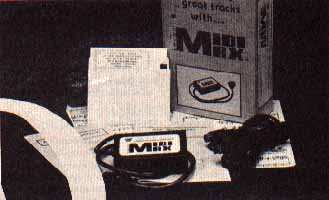MIDIMAX
Affordable 8-bit MIDI choice.
Reviewed by Jeffrey Summers, M.D.

The ATARI ST was the first personal computer to have MIDI ports built in, so the computer could communicate directly with eletronic instruments. Atari 8-bit computers can also support MIDI, but require an interface to do so. One such device is MIDIMAX, from Wizztronics.
The MIDIMAX interface is in a packag with the MIDI Music System sequencing program and another program that will convert files from the popular AMS public domain format into MIDI Music System format. Several songs demonstrating the power of MIDI Music System are also included, such "Flight of the Bumble Bee", "Maple Leaf Rag," and the "Beverly Hills Cop" Theme.
The interface itself is a small, compact unit, about the size of an Atari XM301 modem. It is powered through the serial bus of the computer. It has a connector, so it does not need to be at the end of the daisy chain.
Since it's powered by the serial bus MIDIMAX has the advantage of not requiring a transformer (I'm running out of outlets on my power strip). Unfortunately, this has the disadvantage of causing a voltage drop that might affect the performance of other similar devices. I have used MIDIMAX in conjunction with ICD's P:R: Connection without incident, however.
The metal case appears to be quite sturdy. There are MIDI in and MIDI out connectors, but no MIDI thru. Two MIDI cables are supplied for connecting to your instrument. The interface works without problem.
MIDI MUSIC SYSTEM
MIDI Music System is the sequencing program supplied with MIDIMAX. A sequencer sends a series of notes or instructions to an instrument. MIDI Music System is a full-featured sequencer with 39 tracks, 20 of which may be sent over any of the 16 MIDI channels. MIDI Music System also sends MIDI clock information, allowing you to control drum machines.
Each note in each track is entered as "note-octave-duration." For example, C4Q will play middle C for the duration of one quarter note.
Notes may be entered from a MIDI keyboard as well. However, MIDI Music System does not time how long a note was played. A buffer holds the notes as you play them, and you must then add the note durations from the computer keyboard.
Simple commands let you make changes in patches, key, tempo, pitch wheel and velocity. Controller changes (mod wheel, volume changes, etc.) use a generic statement to set parameters. For example, P7,102 sets controller number 7 to 102. (P7 is the volume controller for most synthesizers).
AMS TO MMS
The conversion program between AMS (Advanced Music System) and MIDI Music System is quite useful, because AMS files are commonly found in user group libraries and on bulletin boards. After conversion to MIDI Music System, you can play these songs on your synthesizer---much more pleasing than the bleeps that the computer produces.
The program does not always seem to correctly translate the files, however. It has particular difficulty with songs that use odd timings for notes, such as triplets. There are other public domain conversion programs that do a better job. The program supplied is better than nothing, but I suggest finding one of the other programs on your local bulletin board, or on Genie or CompuServe.
The manual covers the MIDI Music System program in depth and is quite complete. However, there is no technical information regarding the interface itself. This makes it difficult (though not impossible) to write your own programs using the interface. At least one MIDI handler is available as shareware.
The only problems I have run into in about 6 months of use are probably not related to the interface or software. With my Casio CZ synthesizer, certain notes seem to be "lost"-- not played. The problem occurs most often when a lot of MIDI information is being sent.
I wrote to Wizzttronics about the problem. They confirmed that there is a problem, but only with Casio CZ synthesizers. (Other MIDI interfaces apparently have the same problem with the CZ.) So, I purchased a Roland MT-32 tone generator (a tone generator is essentially a synthesizer without keys) and since then have had no problems when using MIDIMAX.
Essentially, an 8-bit user who wishes to experiment with MIDI has two choices: buy an ST or buy a MIDI interface. The ST is a powerful machine with good MIDI software availability--but it costs a heck of a lot more. There may not be as much software available for the 8-bit user, but the money you save on computers can buy you an extra piece of sound equipment. MIDIMAX is a good package and an excellent introduction to MIDI for 8-bit users.
$229. Wizztronics, P.O. Box 122, Port Jefferson Station, NY 11776. (516) 473-2507.